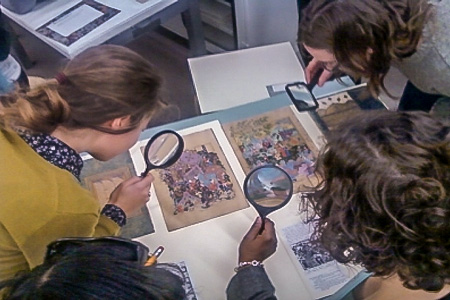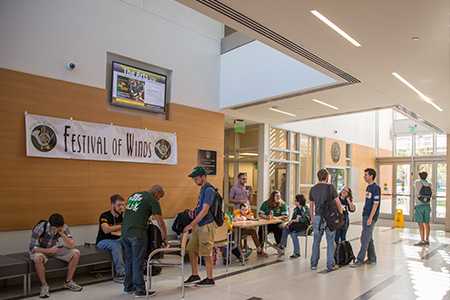MA in Art History Curriculum
Major Requirements
Two study tracks are available to complete the Master of Arts in Art History program. Students can elect to complete a qualifying paper (42 credit hour track) or a thesis (38 credit hour track). Students should consult with the Graduate Coordinator and the faculty to determine which option is the best for them; the final decision rests with the faculty. For either option, a B+ average or above is required in courses taken to fulfill the major's graduate credits, for students to move on to this final phase of their graduate studies.
The MA in Art History is a two-year major for students who attend full time, but the thesis option often takes longer to complete.
| Course | Credits |
|---|---|
|
ARH 6798 Seminar in Art History Students take 6 Art History seminars |
(4 credit hours each) 24 |
|
Students take two core seminars in art history ARH 5813 Methods of Art History (4 credit hours) ARH 5817 Research in Art History (4 credit hours) |
8 |
| Electives (determined by individual consultation with Graduate Coordinator) | 8 |
| ARH 6792 Graduate Qualifying Research and Writing | 2 |
| Total Credit Hours | 42 |
| Course | Credits |
|---|---|
|
ARH 6798 Seminar in Art History Students take 4 critical studies seminars in art history |
(4 credit hours each) 16 |
|
ARH 5813 Methods of Art History (4 credit hours) ARH 5817 Research in Art History (4 credit hours) |
|
|
Students take two core seminars in art history |
8 |
| Electives (determined by individual consultation with Graduate Coordinator) | 8 |
| ARH 6971 Thesis (Thesis Writing) | 6 |
| Total Credit Hours | 38 |
To learn about a range of art-historical methods, graduate students are required to
take the critical studies seminars in a variety of historical periods and taught by
different faculty. A student should, if possible, have at least one graduate class
in these three areas:
- Ancient/Medieval
- Early Modern (15th-18th centuries)
- Modern (19-21st centuries).
Museum experience is encouraged for all students, but course credit for museum internships is limited to those seeking a certificate in museum studies.
Qualifying Paper Option
The qualifying paper option for the Master of Arts in Art History requires 2 core courses (8 hours), 6 seminars in art history (24 hours), with 8 additional hours of electives, plus 2 hours for preparing the qualifying paper (in the fourth and final semester).
The qualifying paper should demonstrate the student's ability to do significant art-historical research, to persuade by effective use of evidence and argument and to write fluently and clearly. The qualifying paper will usually be a substantially revised seminar paper and should be about 15-20 typed pages in length, excluding endnotes, bibliography, illustrations or other materials. Students choosing this option should form a qualifying paper committee by the end of the second semester of their first year. The Committee is composed of a major professor and a second faculty member. Members of the Committee are faculty in the School of Art & Art History, of which one must be tenured or tenure-earning. The major professor will usually be the professor who oversaw the writing of the original seminar paper. Students pursuing this option download the Graduate Student Supervisory form. Students are responsible for collecting committee members' signatures. The Graduate Coordinator must authorize all committee assignments with their signature.
When submitting drafts of the qualifying paper to committee members, students must allow faculty members two weeks to read any given version. Remember that first drafts usually have to be extensively revised, often several times, before the qualifying paper is accepted. Faculty are not normally available during the summer to read qualifying paper drafts.
The qualifying paper committee must approve the qualifying paper before the student can graduate. Qualifying papers must be submitted two weeks before the last day of classes of the semester in which the student wishes to graduate. The major professor, in consultation with the other faculty member, notifies the Academic Advisor of the School of Art & Art History of approval of the paper before the end of the semester. If a paper is not approved, the student may revise and resubmit it a second time. It is the student's responsibility to stay abreast of Graduate School deadlines and registration requirements in the final semester.
Thesis Option
The thesis option for the Master of Arts in Art History requires 2 core courses (8 hours), 4 seminars in art history (16 hours), with 8 additional hours of electives, plus 6 hours of thesis writing (4 hours in the third semester and 2 hours in the fourth and final semester).
Students writing the thesis should work with faculty during the second semester to begin developing potential topics. By the end of the first year, students who wish to write the thesis should decide on a thesis topic with a major professor from the art history faculty. The topic is usually related to research done in a seminar. During the following summer students prepare the thesis proposal.
The proposal should define a significant research problem and explain how the topic has the potential to contribute to scholarship in the field; it must include a research plan and a critical review of the scholarly literature on the subject area. Thesis proposals will be presented to faculty and fellow graduate students in a public forum at the beginning of the third semester. Each presentation is followed by discussion, which provides an opportunity for students to receive suggestions and recommendations from faculty and peers. If the proposal is declined, the student will be eligible to pursue a qualifying paper.
If the art history faculty approves the thesis topic, the student should form a thesis committee by the end of the semester in which they have successfully proposed a thesis topic and have thereby achieved thesis candidacy.
The committee is composed of at least two members and the major professor. The major professor and at least one other committee member must be chosen from tenured or tenure-earning art history faculty, or otherwise as approved by the graduate coordinator of the Master of Arts in Art History. Students forming the thesis committee download the Graduate Student Supervisory form. Students are responsible for collecting committee members' signatures. The M.A. graduate coordinator must authorize all committee assignments with their signature.
While moderate in length and considerably more limited in scope than a doctoral dissertation, the M.A. thesis must demonstrate the student's ability to do original, independent research of publishable quality. The thesis should be approximately 35-40 typed pages of text—the usual length of a journal article—excluding notes, bibliography, illustrations or other materials. When submitting drafts of the thesis to committee members, students must allow faculty members two weeks to read any given version. Remember that first drafts will have to be extensively revised several times before the thesis is accepted. Faculty are not normally available during the summer to read thesis drafts.
The thesis committee must approve the final thesis before the student may schedule a date for the M.A. thesis defense. The examining committee will consist of the thesis committee and at least two additional questioners who are chosen by the student in consultation with the thesis committee. Students should keep in mind that the questioners must also be allowed two weeks to read the draft of the thesis after it is accepted for the defense by the thesis committee. The oral defense is open to the public. No defenses are scheduled during the summer. Immediately after the orals, the examining committee meets to determine whether the student has passed the oral examination and whether the thesis is acceptable in its current form.
NOTE: It is usually necessary to make some changes in the thesis after the oral defense. Allow at least one week between the oral exam and the Graduate School deadline so that you will be able to make the changes.
Ideally, the student will complete the thesis and submit it in the fourth semester. It is the student's responsibility to stay abreast of graduate school deadlines and registration requirements in the final semester. All theses must be submitted electronically.
Transfer of Credit
There is no automatic transfer of non-degree seeking student credit or graduate credit earned at other institutions or from another graduate major in the university towards the Master of Arts in Art History requirements. The School of Art & Art History has designated a six-hour limit on all credit taken as non-degree seeking student status. Any transfer of credit or non-degree seeking student hours to be used toward MA degree requirements are only granted after a faculty review at the time the student has been accepted into the MA.
Undergraduate Deficiencies in Art History
Students pursuing graduate studies in art history, who do not have an undergraduate degree in art history will be expected to complete four undergraduate Art History survey courses plus two courses in critical studies.
Exceptions can be granted only with consent of the art history faculty.

Graduate Catalog
The Graduate Catalog is a rule book of requirements that must be met to graduate. Follow the guides based on the academic year you were admitted to USF.

Financial Aid
The School of Art & Art History and the University of South Florida offer a range of graduate scholarships and financial aid.

Speak with an Advisor
Advisors help with everything from questions about admissions to graduation requirements. They also offer support for your future education and career endeavors.